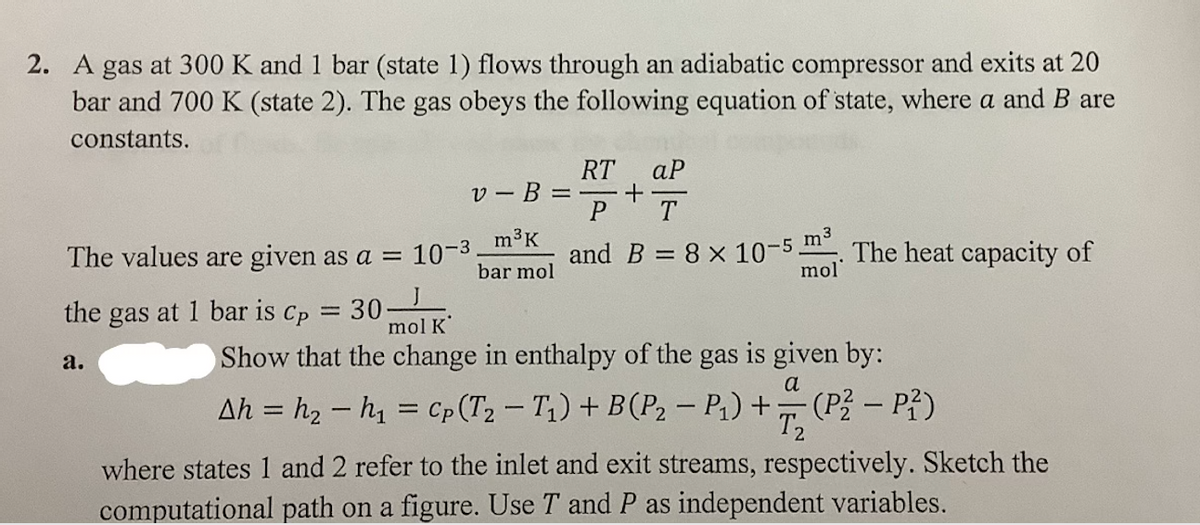A gas at 300 K and 1 bar (state 1) flows through an adiabatic compressor and exits at 20 bar and 700 K (state 2). The gas obeys the following equation of state, where a and B are constants. The values are given as a = the gas at 1 bar is Cp = 30 a. v-B = + m³ K bar mol RT aP P T and B = 8 x 10-5 m³. The heat capacity of mol 10-3. mol K Show that the change in enthalpy of the gas is given by: a T₂ Ah = h₂ − h₂ = Cp (T₂ − T₂) + B (P₂ − P₁) + 7/7 (P² − P²) where states 1 and 2 refer to the inlet and exit streams, respectively. Sketch the computational path on a figure. Use T and P as independent variables.
A gas at 300 K and 1 bar (state 1) flows through an adiabatic compressor and exits at 20 bar and 700 K (state 2). The gas obeys the following equation of state, where a and B are constants. The values are given as a = the gas at 1 bar is Cp = 30 a. v-B = + m³ K bar mol RT aP P T and B = 8 x 10-5 m³. The heat capacity of mol 10-3. mol K Show that the change in enthalpy of the gas is given by: a T₂ Ah = h₂ − h₂ = Cp (T₂ − T₂) + B (P₂ − P₁) + 7/7 (P² − P²) where states 1 and 2 refer to the inlet and exit streams, respectively. Sketch the computational path on a figure. Use T and P as independent variables.
Introduction to Chemical Engineering Thermodynamics
8th Edition
ISBN:9781259696527
Author:J.M. Smith Termodinamica en ingenieria quimica, Hendrick C Van Ness, Michael Abbott, Mark Swihart
Publisher:J.M. Smith Termodinamica en ingenieria quimica, Hendrick C Van Ness, Michael Abbott, Mark Swihart
Chapter1: Introduction
Section: Chapter Questions
Problem 1.1P
Related questions
Question

Transcribed Image Text:2. A gas at 300 K and 1 bar (state 1) flows through an adiabatic compressor and exits at 20
bar and 700 K (state 2). The gas obeys the following equation of state, where a and B are
constants.
v-B =
m³ K
bar mol
The values are given as a = 10-³
the gas at 1 bar is Cp = 30-
a.
RT aP
P
T
and B = 8 × 10-5 m³. The heat capacity of
mol
+
mol K
Show that the change in enthalpy of the gas is given by:
Ah=h₂ h₁ = Cp (T2 - T₁) + B(P₂ - P₁) + (P² - P²)
a
T2
where states 1 and 2 refer to the inlet and exit streams, respectively. Sketch the
computational path on a figure. Use T and P as independent variables.
Expert Solution
This question has been solved!
Explore an expertly crafted, step-by-step solution for a thorough understanding of key concepts.
Step by step
Solved in 3 steps

Recommended textbooks for you

Introduction to Chemical Engineering Thermodynami…
Chemical Engineering
ISBN:
9781259696527
Author:
J.M. Smith Termodinamica en ingenieria quimica, Hendrick C Van Ness, Michael Abbott, Mark Swihart
Publisher:
McGraw-Hill Education

Elementary Principles of Chemical Processes, Bind…
Chemical Engineering
ISBN:
9781118431221
Author:
Richard M. Felder, Ronald W. Rousseau, Lisa G. Bullard
Publisher:
WILEY

Elements of Chemical Reaction Engineering (5th Ed…
Chemical Engineering
ISBN:
9780133887518
Author:
H. Scott Fogler
Publisher:
Prentice Hall

Introduction to Chemical Engineering Thermodynami…
Chemical Engineering
ISBN:
9781259696527
Author:
J.M. Smith Termodinamica en ingenieria quimica, Hendrick C Van Ness, Michael Abbott, Mark Swihart
Publisher:
McGraw-Hill Education

Elementary Principles of Chemical Processes, Bind…
Chemical Engineering
ISBN:
9781118431221
Author:
Richard M. Felder, Ronald W. Rousseau, Lisa G. Bullard
Publisher:
WILEY

Elements of Chemical Reaction Engineering (5th Ed…
Chemical Engineering
ISBN:
9780133887518
Author:
H. Scott Fogler
Publisher:
Prentice Hall


Industrial Plastics: Theory and Applications
Chemical Engineering
ISBN:
9781285061238
Author:
Lokensgard, Erik
Publisher:
Delmar Cengage Learning

Unit Operations of Chemical Engineering
Chemical Engineering
ISBN:
9780072848236
Author:
Warren McCabe, Julian C. Smith, Peter Harriott
Publisher:
McGraw-Hill Companies, The